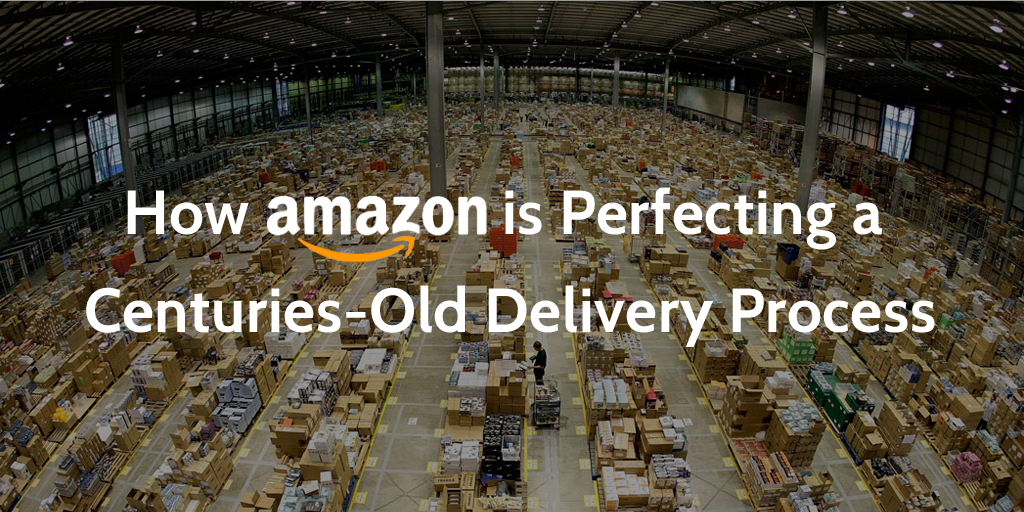
When Captain Picard of the USS Enterprise wants something done, he points his finger and orders someone to “make it so.” This catchphrase is what the retail giant Amazon almost called itself: “MakeItSo.com.”
Doesn’t have the same ring to it, right?

While there’s no finger-pointing involved, this is basically how home delivery services work these days. We browse through a catalog of options, we pick one, we press a button, and poof—it becomes a reality. Whether it’s a box of paper towels, a new book, or a hoverboard, you can get it delivered pretty quickly.
And though this technology seems really like something straight out of Star Trek, the processes underlying it actually go back hundreds of years, for as long as humans have been trying to make home delivery services work.
But the systems and processes that Amazon has become synonymous with really rely on an appetite created by a name that was once a retail giant that cast a shadow as large as Amazon’s: Sears, Roebuck & Co. In fact, Amazon’s success can largely be credited to their ability to perfect processes that Sears innovated and honed throughout the 20th century.
And where Sears failed, Amazon is still succeeding…
…for now.
The Mail-Order Revolution
For most of human history, ordering something from far away was really tricky. Even in an era of globalization, the systems that transported things like dry goods, food, and mail were often unreliable. Entire ships got lost. Packages were mixed up. Mail was sent to the wrong address.
Still, merchants tried to make it work for them, from Dutch furniture builders to Welsh book peddlers in the 1600’s. Historians have found that for the most part, nothing sold, because the processes were so inefficient and untrustworthy.
Ben Franklin’s catalog contribution
That is, until they offered “satisfaction guaranteed,” a promise Benjamin Franklin, of all people, is credited with.
In addition to inventing bifocals, the founding father also invented the customer satisfaction promise. In 1744, he published “A Catalogue of Choice and Valuable Books, Consisting of Near 600 Volumes, in most Faculties and Sciences.” It was one of the first mail-order catalogs to be circulated in America.
Most importantly, it famously included an invaluable piece of text:
“Those Persons that live remote, by sending their Orders and Money to said B. Franklin, may depend on the same Justice as if present.”
Voila. The first ever mail-order guarantee.
With your purchase assured, mail-order catalogs started sounding really appealing. They were primarily used by book publishers and plant nurseries for a long time, since they were small, non-perishable items. These companies started printing and mailing in color to get more attention, even though it was really expensive.

Still, catalogs were only mailed to previous customers, and contained a pretty specialized selection of items. Until the Sears’ catalog came along.
In 1888, Richard Sears, along with his partner, Alvah Roebuck, mailed pamphlets advertising their watches to people all over the mid-Atlantic with mail-order service. They quickly expanded into other goods like bicycles, clothing, and furniture. With no brick-and-mortar store, Sears, Roebuck & Co. was able to spend a lot of money compiling a catalog that was really appealing.
A natural at writing ad copy, Richard Sears declared his 1894 catalog the ultimate “Book of Bargains: A Money Saver for Everyone,” and the “Cheapest Supply House on Earth.” He also made bold claims like “Our trade reaches around the World,” even though they only shipped within the U.S.
The catalog caused the company to take off. His partner, Roebuck, had to sell his shares of the business after the Panic of 1893, and remained attached to Sears, Roebuck, and Co. Lucky for him, it became a household name across the States.
Americans treated Sears the way we now treat Amazon. It was the go-to place for any item, from basics to hard-to find goods. It was the first ever “everything store.” Post World War II, in a boom of American consumerism (especially in malls), Sears opened brick-and-mortars from coast to coast.
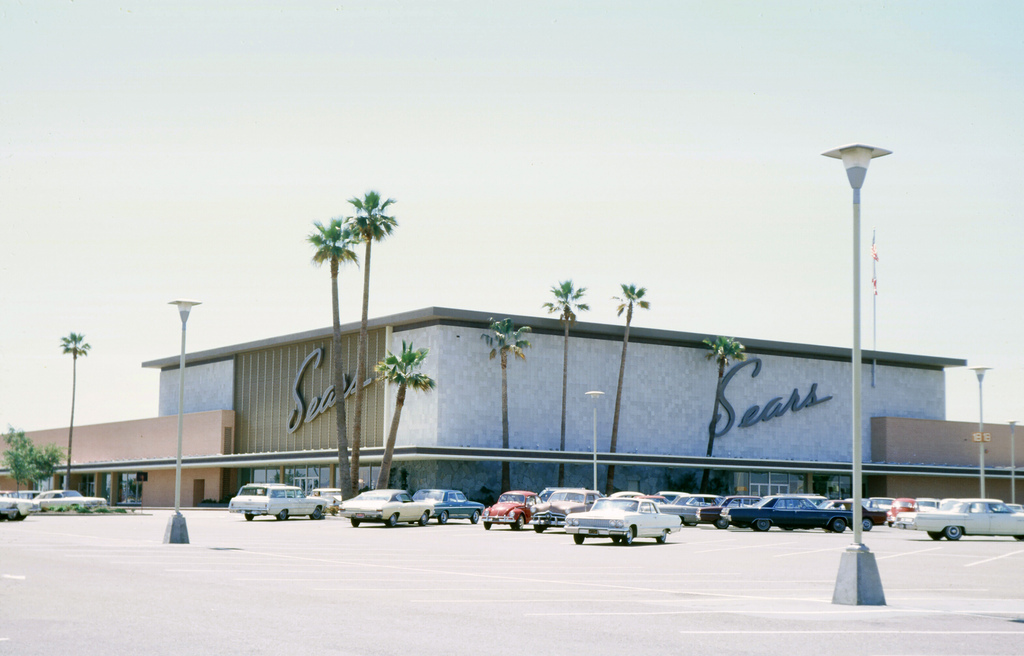
A Sears in LA was the same as a Sears in New York was the same as the Sears catalog—they created brand consistency in a largely inconsistent market.
“The catalog was pure brilliance at a time when (America) was a far-flung nation without a lot of stores. It was really the Internet of the day — a place where anyone, at any time, in any place could take a look, say, ‘Oh my gosh, I need that’ — and get it.”
–James Schrager, a professor of entrepreneurship and strategy at the University of Chicago’s Booth School of Business.
Why Sears (and Amazon) Soared
Even though they’ve taken radically different directions, Sears and Amazon actually had a lot in common. Their early growth strategies and ability to become synonymous with an “everything store” is strikingly similar—especially when you look at some of the processes they put into place.
They took advantage of public roadways
America’s public post system was officially founded in 1775, when the Continental Congress finalized deals that had been in the works for a while—coincidentally, also implemented by Ben Franklin. But it didn’t really take off until the Homestead Act of 1863, when Americans moved West en masse and needed better ways to communicate.
As the federal government encouraged westward expansion in a sweeping frenzy of manifest destiny, they wanted to reassure Americans that they could stay in touch with their families back east. The government introduced free rural delivery in 1896 (just 8 years into Sears’ operation), as well as reduced postage for “aids in the dissemination of knowledge.” Because mailed marketing materials were so new, the Sears catalog qualified.
They could send their catalogs for just a penny—and they were basically the only ones delivering catalogs to such far-flung distances. Sales skyrocketed.
Amazon did an analogous process when the Internet rolled around—the next major overhaul in public information transportation. the same with the Internet—capitalized on something that was changing with the times.
Reliability’s the name of the game
Building reliable processes changed the game.
Even though Franklin promised “satisfaction or your money back,” not a lot of other people picked up on the phrase. There was a high chance that you would ship off your hard-earned money, get a bad product in the mail in a few weeks, and have nowhere to return it.
The Sears Catalog changed that. Even from the very first issue, it stated in bold letters: “We guarantee every article you select to be absolutely satisfactory to you, or you can return it to us at our expense and we will, without question, refund your money.”
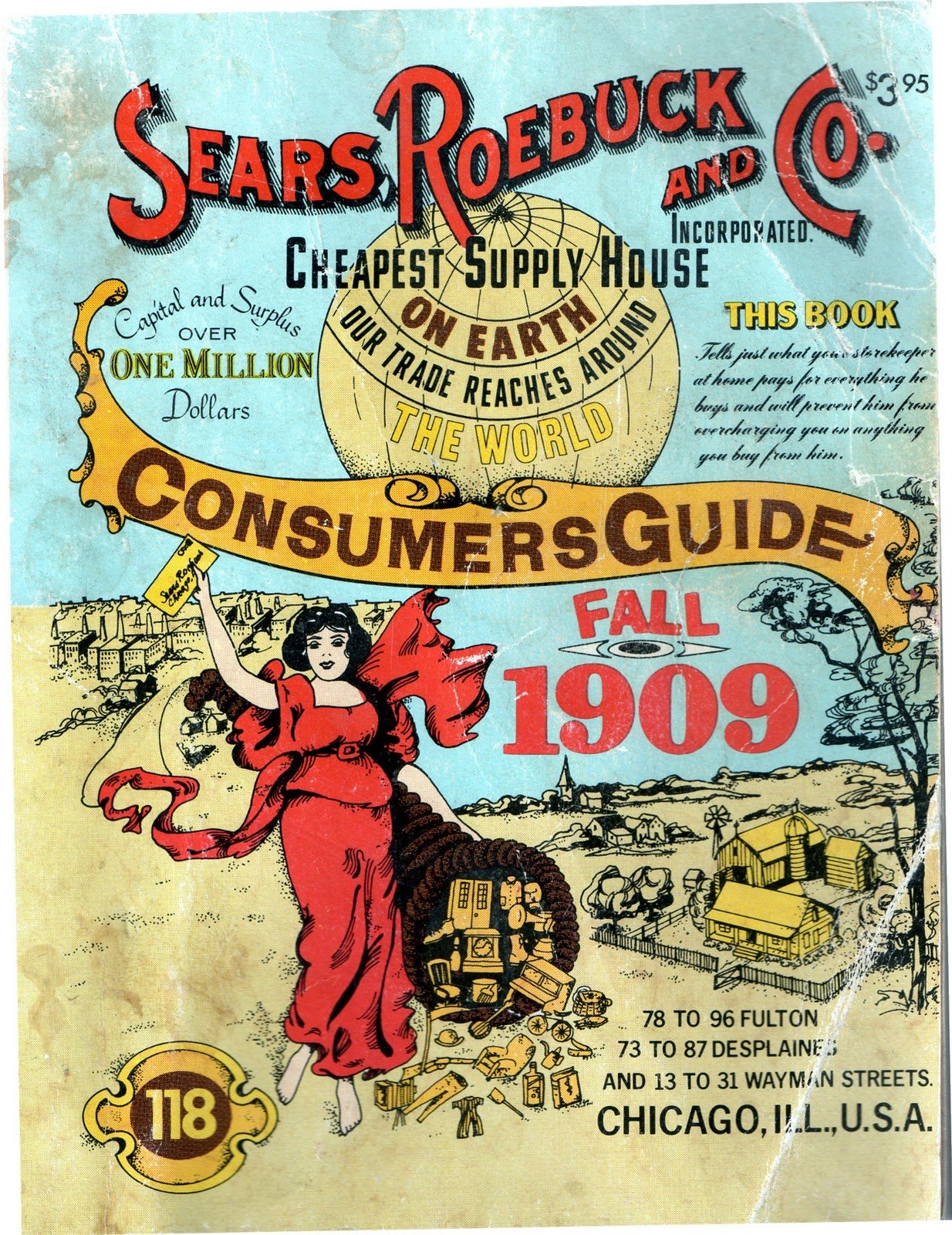
Consumers loved that the transaction didn’t end when their goods arrived in the mail. They now had the opportunity to exchange goods, as if Sears—hundreds of miles away from their remote location—were a local dry goods store down the street. It was invaluable to settlers in the West.
Amazon now does the same thing with its online sales. If you’re not satisfied with a purchase, you can return it, no questions asked. Whereas other stores might just give you credit, or not accept a return, Amazon is know for its reliable refund process.
They turned customers into addicts
Sears also instituted rewards programs in their catalog that encouraged people to buy in bulk, buy with their neighbors, or buy goods on a calendar basis. Not only did the “consumer bible” carry everything, it rewarded big spenders.
In 1903, Sears initiated the first “customer profit sharing” program, which gave them a small amount of credit for every dollar they spent with Sears that could then be redeemed for other products.
With that kind of rewards system, it made sense for consumers to buy everything they needed at Sears—even the blueprints and materials for their new “department store house.”
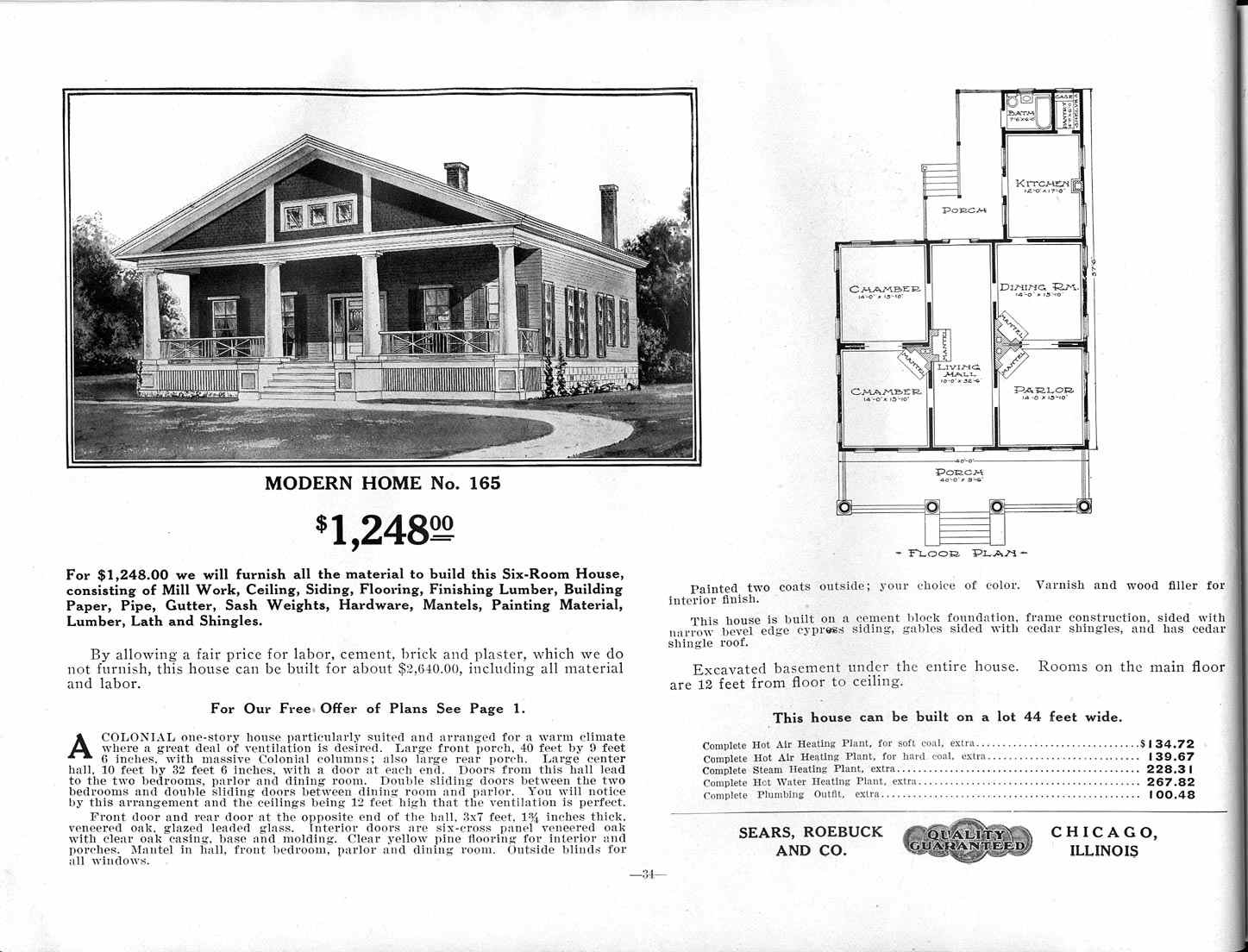
Amazon Prime curated the same kind of customer loyalty.
Amazon’s innovative buy-in delivery system, Amazon Prime, was criticized at first because it made very little financial sense. But according to Brad Stone, Bloomberg journalist and author of The Everything Store: Jeff Bezos and the Age of Amazon, Prime paid dividends when it turned “customers into Amazon addicts who gorged on the almost instant gratification of having purchases reliably appear two days after they ordered them.”
Just take a look at one-click buying, or the Amazon dash button. And it really works. Prime members, it turns out, spend a whopping $1,500 on Amazon per year, which is almost double what average customers spend.
And it’s not just Amazon Prime. Other companies, like the discount shopping site Jet, have managed to coax would-be one-time buyers into consumers who keep coming back for more based solely on their rewards programs. Jet rewards customers for purchasing by discounting future purposes–kind of like a coupon book, but only for things they know customers want. It’s a huge success. Just one month after Jet launched this summer, it was already the #4 marketplace.
They re-invented customer happiness
Sears was one of the first companies to popularize customer reviews. While it was still a marketing ploy, each catalog came with glowing reviews for products from “unbiased” buyers as far back as 1893. Next to a girl wearing her brand new rain boots, you could find a review written by her mother saying how great they were.
Amazon extended this by being one of the first companies to regularly post any customer reviews, positive or negative. This feels counter-intuitive. Why allow consumers to post negative reviews of products, especially since it might deter potential customers from buying?
But Amazon, like Sears, is certain enough of its ability to satisfy the customer that it allows even negative reviews. It creates brand trust and loyalty. Customers rely on reviews to choose what to buy, and know what to avoid based on the 5-star system.
Where Sears Failed (and Amazon is Succeeding)
Sears used to be a staple. By the 1960s, 1 out of nearly 200 U.S. workers received a Sears paycheck, and 1 out of every 3 carried a Sears credit card. The company’s strengths came from anticipating American needs and honing processes that fit them.
The real problems arose when they stopped paying attention to those processes.
The company took a nosedive in the 80’s and 90’s, and the catalog that was once America’s go-to “store” has now been reduced to a struggling appliances and home goods market that doesn’t get a lot of attention or thought these days. It’s the place people don’t want to shop.

The reason for the company’s sudden failure can be boiled down to a few areas. Areas where, if you take a close look, it’s clear Amazon is picking up on and making sure they don’t make the same mistake with their processes in their similar quest to dominate American consumer spending.
Sears’ terrible delivery process
Although you might be used to seeing brick and mortar stores around, Sears actually started as just a mail-order businesses. Their stock was located in a couple of fulfillment centers—one in Chicago, one in Atlanta, one in LA, and a couple on the East Coast. It was faster than other companies, but still not really efficient.
In the early days, staffers received mail orders from customers, opened them, and assembled packages by rolling around the facilities on roller skates to collect the stuff, like waitresses in a bad 50’s-themed diner.
It didn’t make the process run very smoothly. Workers had to travel to different stories of the building to get items, often slipping in elevators because of their roller skates. In addition, things were cataloged by hand, so there was a lot of human error.
They were the best processes available at the time. But as more technology came out, including automation tools that could help with cataloging and delivery, Sears didn’t adapt. Rather than fix the processes, Sears relied on its power and name to continue being a goliath in the field. What did a few wrong addresses matter when you were the unstoppable Sears? The customer would have to come back to them, right?
Unfortunately, Sears wasn’t worrying about the rising number of competitors like J.C. Penney and Macy’s that were quickly catching up to them and stealing customers left and right. This kind of ego is exactly what led to their downfall. As scholar James Schrager of UChicago writes:
“Sears was so powerful and so successful at one time that they could build the tallest building in the world that they did not need. The Sears Tower stands as a monument to how quickly fortunes can change in retailing, and as a very graphic example of what can go wrong if you don’t ‘watch the store’ every minute of every day.”
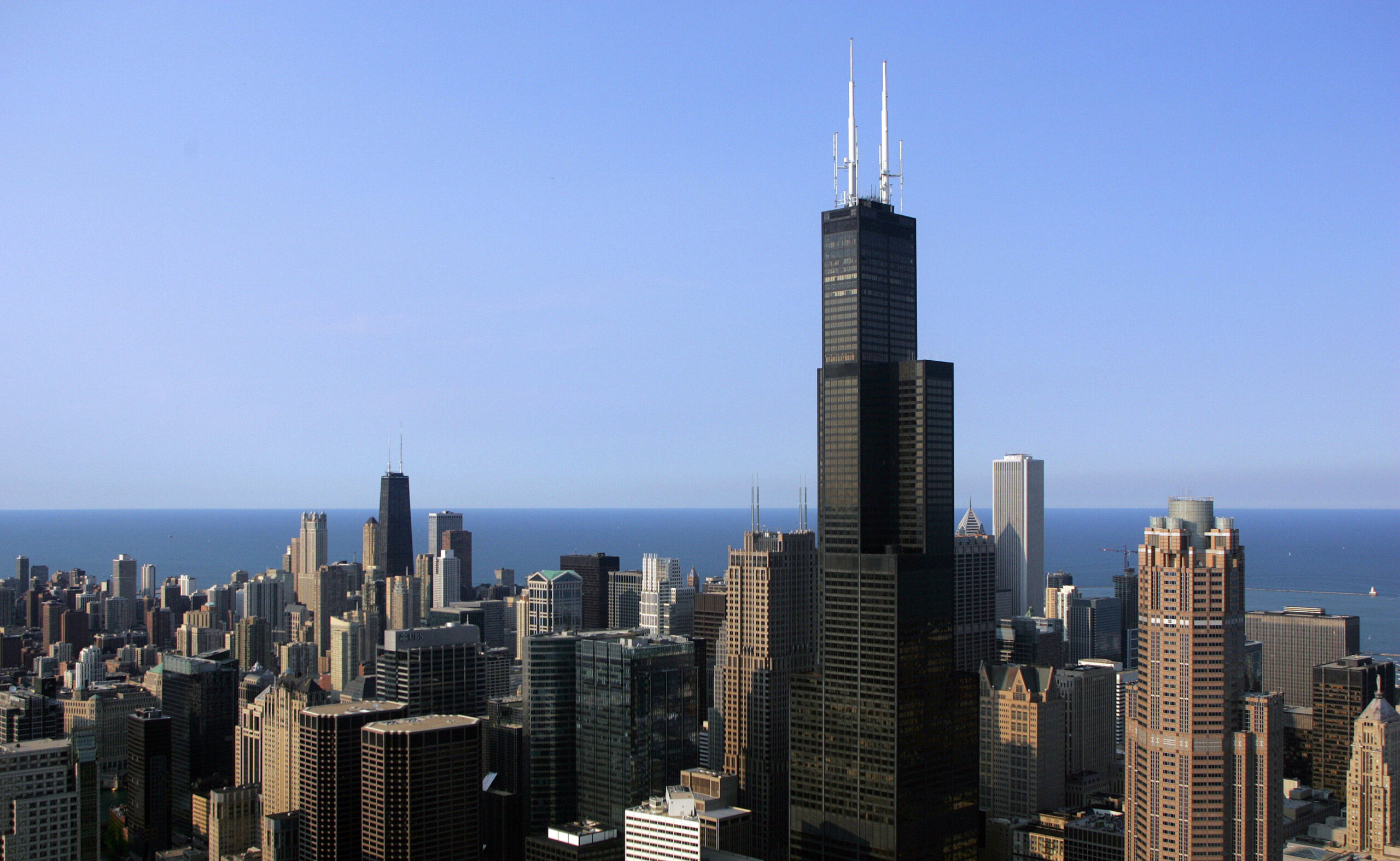
The Sears tower was renamed the Willis tower in 2009—a symbol of changing times and Sears’ inability to change processes.
Amazon’s amazingly efficient delivery process
Amazon, on the other hand, is managing to stay agile while still constantly looking for ways to fill orders faster. They get about 35 orders per second, so they have no choice but to hone their process.
Here’s what goes down. Amazon fulfillment centers are located all over the world—some are the size of about seventeen football fields. They’re staffed by “pickers” who go through crazy hoops to fulfill orders, each equipped with a tracking device that tells them what the next item they have to fetch is, where in the building it’s located, and what’s the fastest route there. They put items in a trolley and bring them to a conveyor belt.
But Amazon’s “pickers” don’t operate anything like Sears’ roller-skating employees. They don’t assemble the packages for customers. They don’t even gather stuff for the same customer.
In fact, all the logistics are decided by a robot called the “mechanical sensei.” It’s a process they’re constantly trying to improve, which is why they’re obsessive about expanding the number of fulfillment centers they have worldwide.
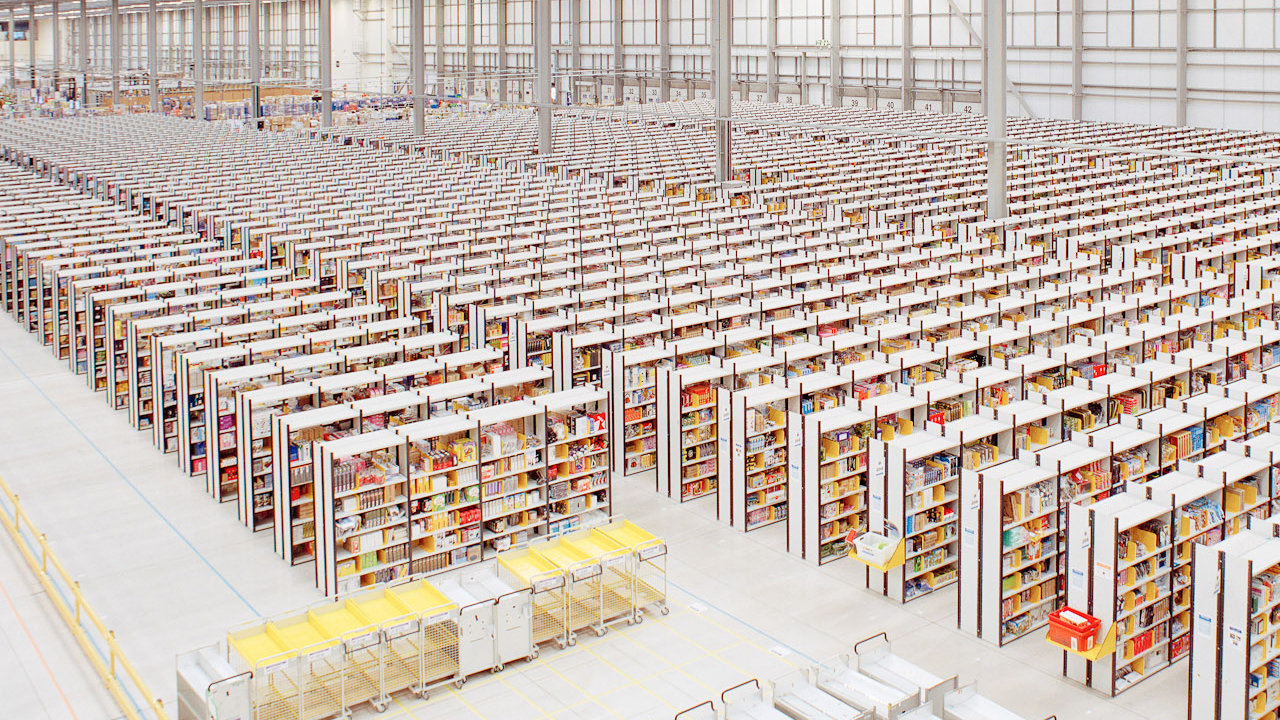
“The invisible hand that orchestrates the symphony that is the Amazon fulfillment center is called the mechanical sensei.”
—Brad Stone.
In addition, it’s not organized at all like Sears’ fulfillment center. Items in the fulfillment center are seemingly randomly placed (eg books are never next to other books). Even though it feels counterintuitive, it makes a lot of sense. This is actually to prevent human error and make sure that items are efficiently placed on the conveyor belt to save time.
You’re less likely to confuse an iPad case with a book than two similar brands of iPad cases.
Sears was a stagnant giant
In addition to not adapting processes, Sears didn’t adapt to the changing American economy.
American appetites were changing. Sears used to be really on top of the ball, anticipating consumers’ desires for mail-order delivery, then the shift to mall-shopping. But when stand-alone box stores hit it big in the 90’s, Sears didn’t jump on the bandwagon. Soon, the store was losing customers to rising companies like Walmart and Target.
Even people within the company recognized that the problems were because Sears was turning a blind eye to process. Arthur Martinez, Sears’ CEO from 1995 to 2000, writes:
“The challenges the company faces today are far worse than ever before, but they’re very much self-inflicted.”
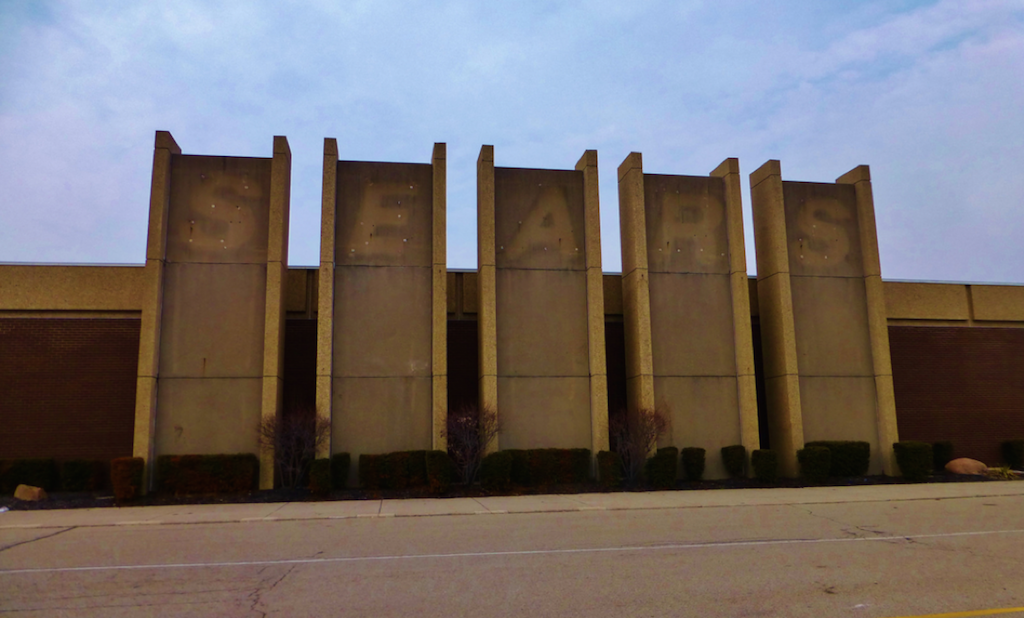
In addition, other companies adapted to Sears’ model. Stores like JC Penney’s, Macy’s, and Land’s End began using the same mail-order catalog. Instead of changing with the times to keep customers loyal, they watched as customers slowly drifted away, until it was too late to do anything about it.
Amazon sets its eyes on the future
Amazon, on the other hand, is always looking for ways to change and improve. For example, they’re finding ways to digitize and computerize the system so that delivery systems are more reliable and more process-driven. One such process: drones.
They’re already in place in some Amazon fulfillment centers. And they’re developing more. They’ve even initiated the “Amazon picking challenge,” an open contest to design better warehouse robots. Still, the company reassures that there will always be humans working at the centers, just in tandem with robots.
In addition, Amazon is always branching out into more fields. Amazon Studios—which they spent over $100 million in one quarter alone to produce original content—is now the unlikely underdog that’s actually winning Golden Globes for its original programming, and Prime Music, which is seeking to take down rival streaming player Spotify.

By focusing on growing into new sectors and taking risks, Amazon ensures they won’t suffer the same fate as Sears—a sudden change in American appetites that they’re unprepared for.
Amazon’s Flywheel
The real difference here is that Amazon has a different model for growth than Sears did. Sears struck gold and relied on that model. Amazon uses a flywheel model, where growth propels more growth. It’s the not-so-secret to their business success—the process that keeps helping them dominate the field.
What’s particularly interesting to note is that the elements of Amazon’s flywheel are dynamic. Customer experience, for example, looked very different in 2000 than in 2016. By making sure that each element of the flywheel process is constantly being watched, they ensure that the model keeps working, and spurring more growth.
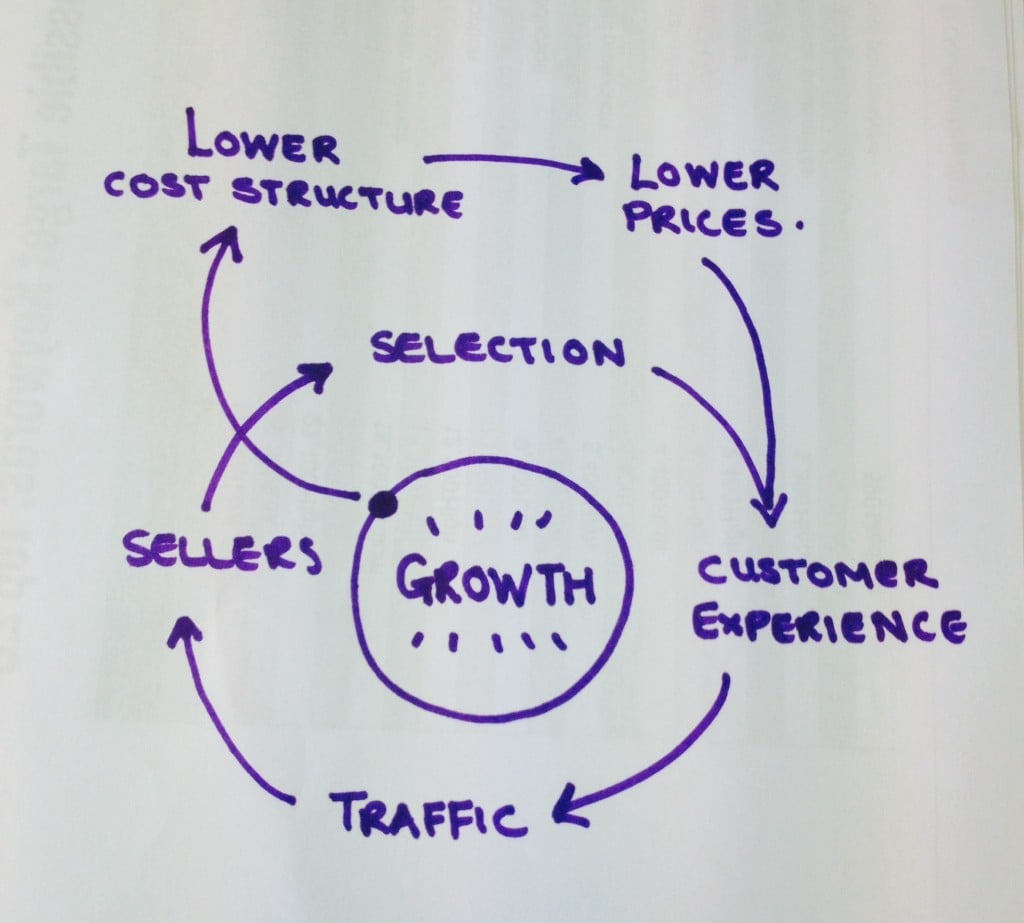
Amazon’s processes aren’t static. They adhere to them rigorously, but when things stop working, they fix it. If Sears had done that with their stores, maybe they’d still be the behemoth they once were.
Testing the mechanical sensei’s limits
Still, it seems like there might be some limits to what Amazon—and its impressive fleet of process-defying robots—can accomplish. For example, one of Amazon’s latest forays has been into food: Amazon Fresh. Can robots really pick out our groceries? John Mackey, co-founder of Whole Foods, predicts that AmazonFresh will be “Amazon’s Waterloo.”
This might be a frontier where drones simply don’t cut it.
All good things must come to an end?
Amazon is getting so good at these processes—in part because of their flywheel model—and building up so much customer loyalty, it might reach its logical extension: cornering the market. Will anti-trust authorities break up Amazon? It’s a highly debated subject, but worth noting because it might change how Amazon operates its business in the future.
Those processes that Dutch traders and Ben Franklin only dreamed of have become a reality thanks to efficient processes—and in the eyes of some anti-trust authorities—maybe too efficient.
It seems fitting, then, that Amazon wound up being named after the river with the most volume of water and not a command from Star Trek. Because while it almost embodies “MakeItSo.com,” it most certainly embodies volume and mass—perhaps so much that it will become a problem in the future.
Download our FREE 111 Page Ebook on Process Automation
Ever wished you could automate the stuff you hate doing at work? Then you need to check out The Ultimate Guide To Business Process Automation with Zapier!
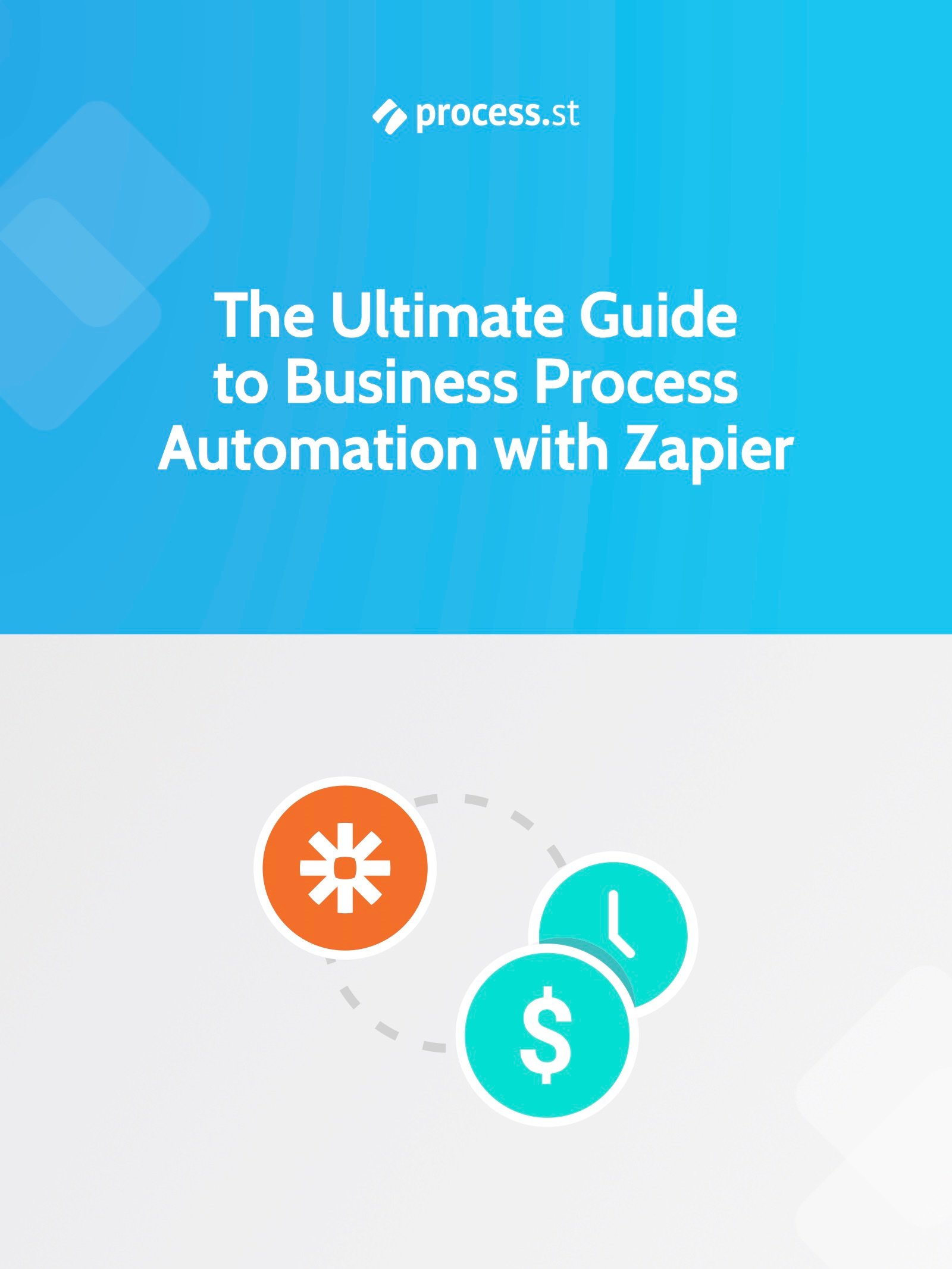
We’ve created the perfect resource to get you saving time and money by automating your business’ processes.
From basic tasks such as saving Gmail attachments into Dropbox to shipping your Salesforce leads into Mailchimp, the Ultimate Guide will guide you through setting up the perfect Zaps to automatically handle the tasks that clog up your schedule.
Plus, with Zapier’s 500+ integrated apps, chances are that your favorite programs are just waiting to be linked!
Better yet, it’s completely free!

What’s in the Ebook?
- What is Zapier – A Brief Introduction to Business Automation
- The Real Power of Zapier – Lookups, Filters and Multi-Step Zaps
- Zapier vs IFTTT: The Best Way to Automate Your Life?
- 222 Zaps You Can Start Using Right Now
- 50 Examples of Business Process Automation from the World’s Most innovative Companies
- 50 more Examples of Workflow Automation using Process Street







 Workflows
Workflows Projects
Projects Data Sets
Data Sets Forms
Forms Pages
Pages Automations
Automations Analytics
Analytics Apps
Apps Integrations
Integrations
 Property management
Property management
 Human resources
Human resources
 Customer management
Customer management
 Information technology
Information technology



Vinay Patankar
CEO and Co-Founder of Process Street. Find him on Twitter and LinkedIn.